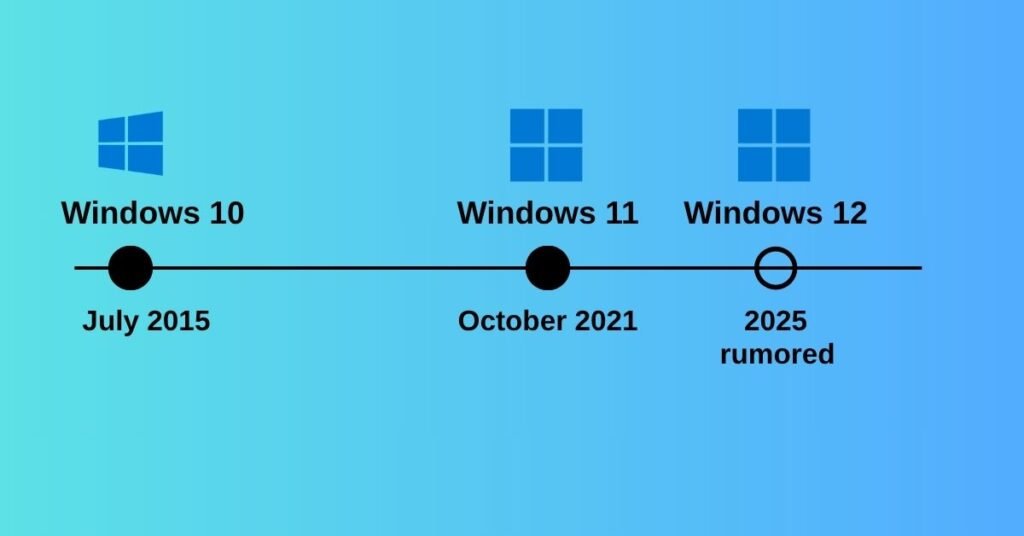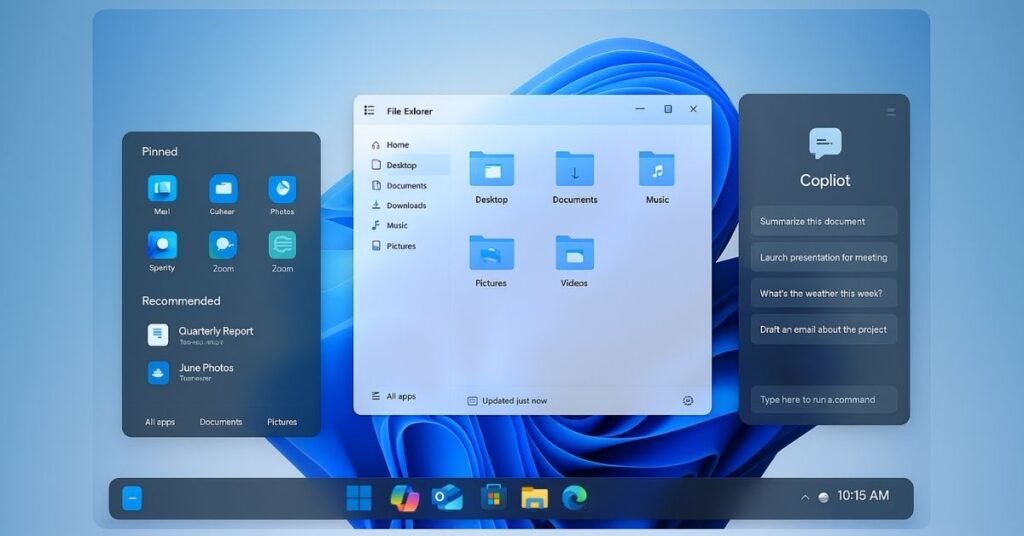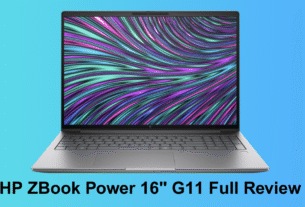Windows 12 rumors and leaks have been swirling in tech circles, fueled by early concept art and insider chatter. Enthusiasts are already comparing what Windows 12 might bring versus Windows 10 and 11 in real-world use. The hints so far point to a heavily AI-driven update, a redesigned interface, and more exacting hardware requirements, even though Microsoft has not made any official announcements to the public.
We will analyze the most recent rumors and leaks, talk about potential UI/UX changes, preview expected features and performance enhancements, and take compatibility and release schedule into account in this in-depth analysis. Our goal is to give you a clear sense of what the next Windows could (and probably will) change – and whether it’s worth holding out for it.
Jump to
Windows 12 Rumors and Leaks So Far
Analysts and insiders note that the timeline for Windows 12 is still up in the air. According to early 2022 reports, Microsoft may resume releasing operating systems every three years (Win10 was released in 2015, and Win11 in 2021). It would represent that Windows 12 would be released in 2024. One report from mid-2022, for example, made the case for a 2024 release based on that three-year cycle.
However, more recent updates cast doubt on a quick turnaround. Microsoft is reportedly focusing on big Windows 11 feature updates (like the 24H2 “Hudson Valley” release), pushing any full Windows 12 launch toward 2025 or later. Windows Central, for instance, notes “the next earliest timeframe for a potential Windows 12 would be fall 2025, with an announcement likely taking place sometime in early summer 2025”.
Still, rumor leaks have built momentum. One report even suggests a Windows 12 beta video leaked online, showing an interface nearly complete (though unconfirmed). The project is said to have the codename “Next Valley” in some circles. Concept designers are also imagining bold changes: for example, Digital Trends covers a fan-made “Windows 12” vision that adopts a Mac-like look with a bottom dock and top-aligned taskbar. Another leaked concept video highlights entirely new taskbar modes – a “dock-like” bar with separate sections for widgets, pinned apps, and quick settings – plus the ability for users to switch between default, classic, compact, or joined layouts to suit different screen sizes.
Whether or not these images are real, one thing seems clear: Microsoft has remained mostly silent (even joking about it on social media) while third parties assemble the puzzle from snippets and leaks. The consensus among credible sources is that nothing is official yet – so treat all these ideas with skepticism. But by aggregating multiple credible reports, we can see a pattern emerging around Windows 12: deep AI integration, a sleeker, possibly modular interface, and a continuing push toward modern hardware.
What Could Windows 12 Improve Over Windows 11 and 10?
From a user’s perspective, every Windows release is judged by how it builds on its predecessors. Windows 10 (launched 2015) felt familiar and customizable, but by 2021 it showed its age. Windows 11 introduced a big visual revamp (centered Start menu, rounded corners, new Widgets pane) and productivity features (Snap Layouts, virtual desktops), but some practical gripes emerged.

Many users missed Windows 10’s robust Start menu (with live tiles and easy categorization), and were frustrated by missing customization options (for example, no off-center taskbar placement or full-featured File Explorer tabs at launch). Performance-wise, Windows 11 could be heavier on some older PCs. With those experiences in mind, Windows 12 rumors suggest Microsoft might try to combine the best of both worlds while adding new smarts.
Customizable Start & Taskbar:
One consistent theme is the need for flexibility. Rumors hint that Windows 12 could let you pick between different Start menu layouts. Concept videos even show toggling between “classic”, “compact”, or modern modes so users can choose a style that fits their workflow. A fan concept imagined adding and arranging widget panels inside the Start menu itself, merging quick controls and app pins in one place.
In practice, this could mean having an “Essentials” column for pinned apps and a separate “Productivity” or “Quick Links” pane – a compromise between Win10’s grid and Win11’s streamlined menu. (One leaked mockup splits the menu into two panels: pinned apps on the left and shortcuts to key folders on the right, with a weather/search header.) Such changes would directly address common requests from Windows 11 users who want more Start menu control.
Revamped File Explorer:
Windows 11’s first File Explorer redesign was met with mixed reviews, so Windows 12 may revisit it. One concept shows a redesigned Explorer with an overhauled Quick Access and recent files list. The idea is a cleaner, more intuitive layout that’s easier to navigate with either mouse or touch – something 10 did well but 11 could refine. If Windows 12 incorporates this, daily tasks like opening documents or searching folders should feel smoother and faster.
Enhanced Productivity Tools in Windows 12:
Windows 12 could also bring new built-in helpers. For example, concept designers have envisioned a “Focus Mode” tool that lets you block distractions across apps (kind of like Focus Assist on steroids). We may see richer features for multiple desktops (e.g. naming and backgrounds per virtual desktop) or smarter window snapping. And, as we’ll discuss more below, an AI-powered assistant might proactively suggest shortcuts or open needed apps based on what you’re doing – making common workflows take fewer clicks.
Performance Optimizations:
Under the hood, every new Windows tries to run leaner and faster if possible. Rumors hint that Windows 12 might tune itself to user habits: for instance, system monitors in a concept envision a PC that “understands your workflow” and automatically adjusts CPU and battery use according to the apps you’re running. In practice this could mean subtle gains in responsiveness or battery life as the OS learns when to throttle background tasks and when to boost performance. Windows 10 vs 11 users have noted that animations and startup times have changed; ideally, Win12 will refine these so the UI feels swift on modern hardware.
Gaming and Media:
While not heavily leaked yet, one would expect Windows 12 to keep improving gaming features (DirectStorage, Auto HDR, Game Mode) introduced in Windows 10/11. Some analysts even wonder if Microsoft will embrace new form factors (like handheld Windows gaming PCs or improved streaming integration with Xbox services) to capture emerging trends. Only time will tell which make the cut, but the groundwork seems focused on AI and productivity first.
Overall, the pattern from these rumors is clear: Windows 12 is likely to bridge gaps left by Windows 10/11. It may combine the flexibility users loved in Win10 (more Start menu choices, customizable layouts) with the slickness of Win11 (a clean interface and animations), while adding a layer of AI “smarts” on top. Of course, this is still conjecture – leaks from credible sources suggest these directions, but Microsoft will decide the final feature set. For now, we can be cautiously optimistic that any legitimate Windows 12 would learn from user feedback and aim to make daily tasks easier than they are today.
Windows Possible UI/UX Enhancements

A key area of focus is the user interface itself. One leaked concept shows Windows 12 with a totally revamped widget panel: a sidebar that hosts everything from quick controls (brightness, volume) and performance monitors to calendars and reminders. In this mockup, you can see a “Widgets Library” on the left side, letting you pin or unpin elements like quick toggles and a mini calendar. This kind of design would centralize often-used tools – imagine having battery/power graphs or system stats always just a click away. (By contrast, Windows 10 had static desktop gadgets and Win11 has a separate Widgets area; Windows 12 might merge these ideas into one customizable dashboard.) Microsoft actually explored similar ideas: in 2022 it leaked an experimental UI that moved system tray icons and search to the top and used a Mac-like floating dock at the bottom.
That concept was meant to adapt between tablet and desktop modes with fluid animations. Whether or not that exact design ships, it shows the direction: Windows 12’s UI is expected to feel more fluid and unified, potentially even modular, so you could toggle features on or off without a huge monolithic update.
Another mockup (pictured above) imagines the Windows 12 Start menu splitting into two panels. On the left are your pinned apps and favorites (similar to today), and on the right are quick-access folders like Desktop, Documents, and settings. This design hints at more customization – for example, it suggests you could rearrange widgets or links in the Start pane at will. Tech editors have noted that concept videos for Win12 even envision multiple start/taskbar modes: users could switch between default, classic (left-aligned), compact, or docked styles.
In practice, this means that if you prefer the old Windows 10 look, you might enable a “classic” mode, whereas on a tablet you’d use a more touch-friendly mode. All of these moves – from flexible taskbar positioning to new animations and color themes – point to a user experience that can adapt more to different use cases. In short, Windows 12’s UI/UX could be a “choose-your-own-adventure” of layouts. Industry observers remind us that Microsoft traditionally reserves big UI overhauls for major releases, so if any of these designs are real, Win12 is the likely vehicle to deliver them.
Windows Expected Features and Performance
Leaked info consistently emphasizes AI integration as Windows 12’s killer feature. In concept art (above), you can see the idea of a system-wide Copilot hub: an always-available panel that offers help, suggestions, and AI-generated content right in your desktop. Analysts suggest Windows 12 will weave AI “into the heart of the system, not as a bolt-on”. For example, we might get an assistant that scans your open documents and emails to offer relevant tips, or which recognizes the context of what you’re doing and surfaces shortcuts automatically.
Windows Central specifically mentions features like an assistant that “can provide contextual suggestions based on what you’re looking at” and even “recognize people in emails or conversations” to streamline your workflow. If true, you could see AI hinting “Hey, I see you’re chatting about a meeting – maybe open your calendar app” or auto-summarizing a lengthy email into bullet points.
Beyond Copilot, search and recall are expected to get smarter. Rumors talk of an AI-enhanced search that understands your intent, not just keyword matching, and even a “Windows Recall” feature that remembers your past activities for quick lookup. Imagine typing “show me the email from Sarah about the budget” and Windows actually pulls it up because it recognized the context of “Sarah” and “budget” in your history.
Windows 12 is also likely to automate multitasking. Leaked feature lists include “smart window management” – for example, automatically grouping apps by project or usage, or offering to snap together the tools you often use in sequence. Notifications and settings might similarly adapt: if you always mute your chat app when you open a game, the OS could learn to do it for you.
Under the hood, performance tuning is a big topic. One leak imagines a PC that “understands your workflow” and dynamically adjusts power usage and performance modes around it. In practice, Windows 12 might optimize CPU and GPU schedules based on whether you’re streaming video, editing photos, or writing code – potentially squeezing out better battery life or responsiveness.
Security and accessibility could get AI boosts too. Reports mention adaptive threat detection that learns your patterns and locks down suspicious activity in real time. Accessibility tools might also use on-device AI for features like live captioning and content summarization.
Putting this together, here are some expected new features in Windows 12:
- Integrated AI Copilot: A context-aware assistant throughout Windows that offers help and actions in any app.
- Smarter Search & Recall: Natural-language search that understands intent, plus a “recall” memory of past activities for quick retrieval.
- Intelligent Task Management: Automated window grouping and adaptive Snap layouts based on your habits.
- Adaptive Performance: System that tunes CPU/GPU usage and power dynamically to match what you do.
- AI-Powered Security: Real-time threat monitoring that adapts to your usage patterns, along with AI features like instant captioning or summarization for media.
- Hardware-Optimized Features: Expect many of the fancy AI tricks to require new hardware (dedicated NPUs/GPUs) for on-device processing.
These features, if real, would make Windows 12 feel very different at a fundamental level. Microsoft is clearly betting that the next OS will be defined not by a handful of apps, but by an always-on intelligence that helps you across tasks. For now, though, all of this is based on leaks and educated guesses. Nothing (again) is confirmed until Redmond announces something.
Windows 12 Release Date and Compatibility
So when might Windows 12 actually hit? Based on available clues, the earliest realistic timeframe seems to be late 2025 or beyond. One analysis points out that after Panos Panay left Microsoft, plans changed: what was expected as Win12 in 2024 became a continuation of Win11, pushing a true Windows 12 release to fall 2025 at the earliest. Tom’s Guide echoes this, noting that “reports now suggest a 2025 launch date” and that many planned Win12 features might ship first as part of Windows 11’s 24H2 update. In practical terms, that means Microsoft would likely announce Windows 12 in mid-2025 and release it later that year or in early 2026, following the pattern of previous OS launches.
Compatibility requirements are expected to be strict. If anything, Microsoft will probably continue the trend of raising the bar. All signs point to TPM 2.0 and Secure Boot remaining mandatory, just as they were for Windows 11. Windows 11 already requires at least an 8th-generation Intel Core or AMD Ryzen 2000-series CPU; leaks suggest Win12 could push that baseline higher (perhaps to 10th/11th-gen Intel or newer AMD chips). Windows Central explicitly says a potential Windows 12 “could up these requirements further” than Windows 11’s. In practice, this means that any PC only just able to run Windows 11 today may not qualify for Windows 12 without a hardware upgrade. (A summary of one leak bluntly warns: if your PC was borderline for Win11, it will “struggle” with Win12’s minimum spec.)
Moreover, because AI features seem core to Windows 12, older PCs may only get a limited experience. One report notes that “a lot of this AI integration depends on hardware support”. In other words, machines without a modern Neural Processing Unit (NPU) or capable GPU might only run the basic OS, with the AI-driven functions reserved for newer systems. On the flip side, there are rumors that Windows 12 will add support for cutting-edge chips. For example, PC Gamer reported that Microsoft is planning a Windows 12 build (codenamed “Germanium”) specifically to support Qualcomm’s upcoming Snapdragon X Elite ARM processor. If true, that signals an intent to embrace ARM-based PCs and high-performance mobile chips alongside traditional x86 CPUs.
Finally, there’s the practical matter of timing and planning. Windows 10 support ends in October 2025, which means organizations and users will need to move off Win10 by then. If Windows 12 won’t arrive until after that, most users will be forced to upgrade to Windows 11 in the interim. In short, don’t expect to stay indefinitely on Win10 waiting for Win12 – by late 2025 you’ll need a supported OS, and that will likely be Win11 unless Microsoft dramatically extends Win10 support.
Final Thoughts: Should You Wait for Windows 12?
With all these exciting rumors, it’s natural to wonder if you should just hold off on upgrading until Windows 12 arrives. The practical answer for most users is: probably not. Every credible report stresses that Windows 12 is far from confirmed, and anything we “know” is tentative. In fact, Tom’s Guide cautions that what we’ve heard so far is unofficial and should be treated skeptically. Many of the headline-grabbing AI features might appear first in Windows 11 updates (the upcoming 24H2 “Hudson Valley” release, for example) before Windows 12 ever ships.
Meanwhile, Windows 10’s end-of-life is looming. If you’re on an older PC that meets Windows 11’s requirements, it makes sense to upgrade to Windows 11 rather than skip ahead. By the time Windows 12 finally ships (likely late 2025 at the earliest), Windows 11 will have matured and will still be supported for years. Holding out for Windows 12 would mean missing security updates after Windows 10 support ends and delaying all the useful improvements in Windows 11.
That said, if you’re curious and have a modern test machine, there’s no harm in following the leaks. The Windows 12 rumors suggest very ambitious plans: a more intelligent OS that learns from you, with slick new layouts and widgets. But remember: it’s all speculation until Microsoft says “go”. For now, the best path is to keep your current Windows up-to-date and watch how the Win12 rumors evolve. If and when Microsoft officially announces Windows 12, we’ll know for sure which of these leaks were on track. Until then, enjoy the journey – and maybe try out some of the rumored concepts in imagination, but don’t bet your upgrade schedule on them just yet.
For more breaking tech news, trusted guides, and the latest on Windows 12 and beyond, follow TechnoByyte.



